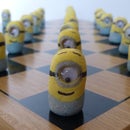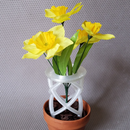Introduction: (Un)rolling Along: 3D Printed Seat Bag and Fender
This started out as a serious project to design a combination seat bag and fender, but somewhere along the design process I decided to make it look like a roll of toilet paper blowing in the wind...
Step 1: Materials
I chose 3D printing for the initial prototype and maximized the size for my printer (Craftbot +).
This version was printed as a single assembly and at 0.3mm layer resolution it still took 11 hours to print.
I mounted it to the seat with cable ties, but for a more secure fit I would make a top plate and use screws.
I used PLA filament for ease of printing, but PLA does not bend much before breaking. For a more durable part I would consider ABS, PETG, or even Nylon filament.
NOTE: I have attached individual files at the end to allow the "paper tube" to be printed in a different color and to create the seat bag storage feature.
Step 2: Use "Sweep" Feature to Create Waves
There are already many good Instructables on Fusion 360, so I will only focus on the main features of this design.
- To create the waves, I started by Sketching a simple sawtooth pattern.
- Use Sketch, Fillet to round out the corners.
- Drag the endpoints of the lines and adjust the size of the radii to achieve the desired wave profile.
- Stop Sketch.
- Sketch the cross-section of the paper perpendicular to the wave and Stop Sketch.
- Use Create, Sweep to create the wave.
Note: At this point I could have specified a Sweep "Twist Angle" to twist the end of the paper, but at the time I wasn't sure how I wanted to show the end of the paper fluttering in the wind.
Step 3: Use "Loft" Feature to Create Tail Section
- Construct, Offset Plane to define the length of the tail. In my case this was defined by the size of my printer.
- Sketch the end profile of the tail. I chose a simple twist, but could have added a ripple, etc.
- Stop Sketch.
- Sketch, Project/Include, Project and select the end profile of the wave.
- Stop Sketch.
- Create, Loft to create a tail with a slight twist to it.
Step 4: Use Planes and "Mirror" Feature to Center Hole Pattern
- Construct, Plane at an Angle to define a plane for the mounting holes.
- Construct, Offset Plane to define a plane beyond the part (i.e., looking down at the part).
- Sketch mounting holes. I could have drawn all 4 holes at one time, but chose to mirror them so that the hole pattern remains centered on the part (Note: You can also mirror the holes in the sketch and skip step 5 - personal preference).
- Extrude, Cut the holes, either a fixed distance, or in my case, I chose the inner cylinder to stop.
- Create, Mirror the holes about the middle plane of the part (Note: If the original cylinder was extruded in one direction instead of symmetric, you'll need to construct a middle plane).
Step 5: Files (IGES, STEP, STL, Fusion360)
Additional CAD files:
- Fusion 360 files
- IGES/STEP files
- STL files (individual and single assembly)
Hope you got a chuckle (or at least a smile) from this fun(ny) and functional project.
Attachments

Participated in the
Epilog Challenge 9

Participated in the
Wheels Contest 2017


















